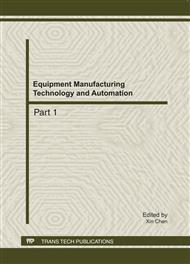p.1960
p.1964
p.1968
p.1974
p.1979
p.1983
p.1989
p.1993
p.1999
Cutter Radius Compensation for Five- Axis Peripheral Milling in CNC System
Abstract:
This paper presents a 3D tool radius compensation for five- axis peripheral milling in CNC systems. Using a generalized kinematics model of five- axis machines and uniform algorithm, it is possible to calculate the complete analytical equations for the tool orientation relative to part. The tool orientation relative to part selecting as Z-axis is used to establish compensation coordinate system. The points in the machine coordinate system are converted to the compensation coordinate system. The compensation points in the compensation coordinate system using these points can be calculated. This computation procedure is similar to the calculation of cutter compensation C. The compensation points in machine coordinate system can be obtained by converting the compensation points in the compensation coordinate system to machine coordinate system. The presented methodology was used in the CNC system, which makes the CNC system more efficiently and systematically
Info:
Periodical:
Pages:
1979-1982
Citation:
Online since:
August 2011
Authors:
Price:
Сopyright:
© 2011 Trans Tech Publications Ltd. All Rights Reserved
Share:
Citation:


